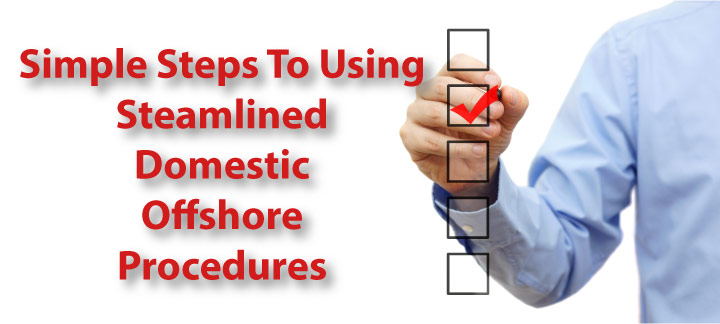The Simple Steps to Using the Streamlined Domestic Offshore Procedures
If you are eligible to use the Streamlined Domestic Offshore Procedures, then you must follow particular steps. If you fail to properly comply with the steps, then your application will be rejected for the streamlined procedures. Instead, your tax return will simply be processed in the usual manner and you will not be able to avail yourself of any of the benefits of the streamlined domestic offshore procedures.
Step 1: Complete Amended Tax Returns
The first step to completing an application for the Streamlined Domestic Offshore Procedures consists of completing amended tax returns for certain years. To complete this first step in the process, the taxpayer must submit complete and accurate amended tax returns for the most recent three years for which the tax return due date has passed. In submitting these amended tax returns, the taxpayer must use Form 1040X, Amended U.S. Individual Tax Return, as well as file any required informational returns, including Forms 3520, 3520-A, 5471, 5472, 8938, 926, and 8621. These informational returns are required under the streamlined procedures even if the taxpayer would not have typically filed those information returns with his or her Form 1040 tax return.
Step 2: Label Your Application
In order to ensure that your application under the Streamlined Domestic Offshore Procedures is properly labeled as such. The IRS has specified that each page of each amended tax return submitted under these procedures is labeled with “Streamlined Domestic Offshore” written in red ink. This labeling requirement is absolutely critical to identify that your returns are being submitted under the streamlined procedures. If you fail to properly label your returns in this manner, you will not be able to participate in the streamlined procedures and your returns will be processed in the usual manner. As such, you may miss out on all the benefits under the program.
Step 3: You Must Make a Specific Certification
The next step in the streamlined domestic offshore procedures requires the taxpayer to make a statement certifying certain important eligibility elements. In this statement, the taxpayer must first certify that they are eligible to participate in the Streamlined Domestic Offshore Procedures. The taxpayer must also certify that the failure to file income tax returns, pay income tax, and file the FBAR forms and other information returns was due to non-willful conduct. The statement regarding non-willful conduct is extremely important to the taxpayer’s submission because the streamlined procedures do not protect willful conduct. Next, the statement should certify that all delinquent IRS FBARs have been filed in accordance with the rules of the program. Finally, the taxpayer must include a calculation of the miscellaneous offshore penalty in the submission, and the statement must certify that the calculation completed by the taxpayer is accurate.
In addition to completing the signed certification, the taxpayer must retain all information and documentation to support the statements made in the certification, and be able to produce the documentation upon request by the IRS. Multiple copies of the statement itself should be made and a copy should be attached to each amended return and information return submitted to the IRS as required under the streamlined procedures. However, these statements are not required to be attached to the updated FBAR reports submitted under the streamlined procedures. The IRS provides the following warning: “Failure to submit this statement, or submission of an incomplete or otherwise deficient statement, will result in returns being processed in the normal course without the benefit of the favorable terms of these procedures.” Thus, this signed certification is another absolutely critical step in the streamlined domestic offshore procedures. Failure to provide the statement will prevent the taxpayer from benefitting from the program.
Step 4: Pay Taxes and Title 26 Penalties
As the next step in the streamlined procedures, the taxpayer must submit payment of all tax due as reflected on the amended tax returns filed under the process. In addition to paying the applicable tax, the taxpayer should pay all applicable statutory interest with respect to each of the late payment amounts and payment of the Title 26 miscellaneous offshore penalty. In order to ensure that your tax payment and penalties are properly processed, you should include your taxpayer identification number on the check. In the event that you miscalculated the tax due, interest, or penalty amounts, you may receive a balance due notice or a refund.
Step 5: File All Delinquent FBARs
A final step in complying with the streamlined domestic offshore procedures requires the taxpayer to file any delinquent FBARs for each of the most recent 6 tax years for which the FBAR due date has passed. In doing so, you must explain that you are filing the delinquent FBARs in attempt to comply with the streamlined domestic offshore procedures. Most importantly, the FBAR filings must be made electronically under the streamlined procedures. In order to indicate that these FBAR filings are made under the streamlined procedures, you must enter “Streamlined Filing Compliance Procedures” in the explanation box on the electronic filing website. This step is very important because it explains why you are filing the FBAR late, and also puts the IRS on notice that you have completed the final step in the Streamlined Domestic Offshore Procedures submission process.
How a Tax Attorney Can Help
If you have undisclosed offshore foreign accounts or assets, you may be eligible to participate in the streamlined procedures under Offshore Voluntary Disclosure Program. In order to evaluate whether the streamlined procedures apply to your international tax situation, you should consider consulting a knowledgeable international tax attorney. The OVDP program is rapidly changing, but a tax attorney can help you navigate the confusing aspects of the IRS program.
The Tax Lawyer - William D Hartsock Tax Attorney Inc. has been successfully helping clients with tax issues related to their foreign assets since the early 1980s. Mr. Hartsock offers free consultations with the full benefit and protections of attorney client privilege to help people clearly understand their situation and options based on the circumstances of their case. To schedule your free consultation simply fill out the contact form found on this page, or call (858) 481-4844.



Comments (0)